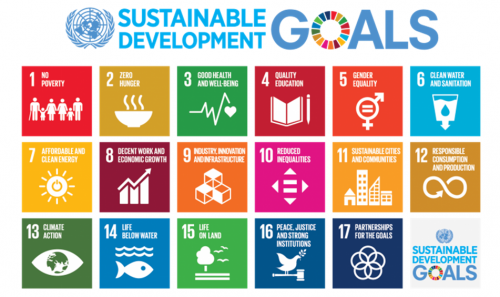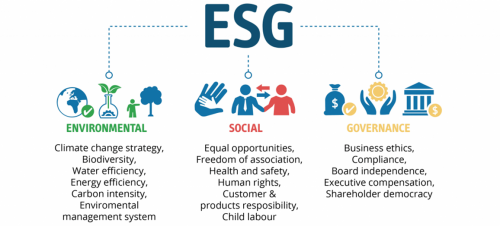Table of Content
Polls
Polls
What Is Sustainability
Module 1: What is Sustainability?
 Learning Objectives
Learning Objectives
- This module introduces readers to key sustainability concepts such as ESG and the SDGs.
- Readers will become familiar with the concept of carbon footprint and sustainability data.
- The glossary will enable readers to navigate through the terms used throughout this toolkit.
Organizations are being held accountable for their impact on the world.
Private companies and organizations are increasingly being held accountable by their stakeholders – including employees, clients, investors, business partners, governments and civil society – to operate in a way that is “sustainable,” which means that it does not negatively impact the planet and its people.
The internationally accepted global framework for sustainability is the United Nations’ Sustainable Development Goals, (SDGs). The SDGs are a collection of 17 interlinked global goals and 169 targets designed to be a “blueprint to achieve a better and more sustainable future for all.” They were adopted in 2015 by government members of the United Nations and are intended to be achieved by 2030. This global sustainability agenda recognizes that ending poverty and other deprivations must go together with strategies that improve health and education, reduce inequality, and spur economic growth – all while tackling climate change and working to preserve our oceans and forests.At its core, sustainability means meeting the needs of the present without compromising the ability of future generations to meet their needs. Businesses have embraced this challenge by acknowledging their environmental and social responsibility.
ESG (Environmental, Social, and Governance) criteria as a framework for sustainable businesses
In corporate terms, non-financial factors are collectively referred to as ESG (Environmental, Social, and Governance). As such, ESG is an extension to the concept of the “triple bottom line”, which postulates that business performance may be measured in relation to finances, environmental impact, and social responsibility. Increasingly, organizations are expected to manage these impacts in their own operations and in their wider value chains. For the purposes of this toolkit, we are zooming in on the “E” of ESG, and more specifically, on climate action, being one major component of environmental impact.A global movement for climate action
The movement for companies to adopt climate action was accelerated by the Paris Agreement (or the Paris Climate Accords), an international treaty adopted in 2015 at the UN Climate Change Conference (COP21) in Paris, limiting global warming to below 2 (preferably 1.5) degrees Celsius, compared to pre-industrial levels. Today, almost 200 countries have signed the agreement, and their progress is reviewed every five years by the United Nations Framework Convention on Climate Change (UNFCC).“Climate change is one of the greatest challenges of our time and its adverse impacts undermine the ability of all countries to achieve sustainable development. Increases in global temperature, sea level rise, ocean acidification and other climate change impacts are seriously affecting coastal areas and low-lying coastal countries, including many least developed countries and small island developing States. The survival of many societies, and of the biological support systems of the planet, is at risk.” (Source: https://sdgs.un.org/2030agenda )
One of the campaigns resulting from the Paris Agreement is the UN-backed “Race to Net Zero,” a global movement targeting non-state actors such as businesses, local/regional entities, investors, and even universities. Signatories are committed to achieving net-zero carbon emissions by 2050 (or “carbon neutrality” which means that an entity is balancing its carbon emissions with carbon removal or, ideally, eliminating emissions altogether). Forbes reported that a fifth of the world’s largest companies had committed to Net Zero targets in May 2021, including representation from all of the major travel verticals.
Taking this one step further, at COP26 in 2021, the Glasgow Declaration was launched, which aims to catalyze commitments to Net Zero emissions within the tourism industry specifically. Signatories, including destinations, businesses, and supporting organizations, pledge to develop a Climate Action Plan within 12 months. A Climate Action Plan should include specific goals and actions to measure climate impacts, decarbonize or reduce emissions, regenerate or restore ecosystems, collaborate to execute plans, and sustainably finance these objectives. By April 2022, more than 500 tourism businesses had signed , including hotels, visitors’ and convention bureaus, tour operators, airlines, NGOs, etc.
If a company is signed on to any of these initiatives, it means that they are going to be adjusting their policies to align with climate action objectives – and fast.
Climate action: Getting familiar with the terminology
It’s impossible to adopt climate action in the business travel sector without understanding some of the key terms and concepts around climate change. Here are the basics:Global warming is caused by the buildup of certain gases in the atmosphere that trap heat. Because of their warming effect, these gases are called greenhouse gases (GHG), with carbon dioxide (CO2) being the primary gas linked to global warming (other GHGs include methane, nitrous oxide, sulfur oxide, and hydrofluorocarbons). CO2 is released into the atmosphere through natural processes or, increasingly, human activity, and the main sources of this are fossil fuel consumption (for things like electricity, heat, and transportation) and deforestation. An important component of climate action is to reduce the amount of CO2 being released into the atmosphere by modifying these activities. As such, entities such as companies, regions, and entire nations are increasingly monitoring and addressing their carbon footprint, which includes the emissions for which they are both directly and indirectly responsible.
Entities can track and report their CO2 (carbon) emissions specifically, but it is recommended that they track the carbon equivalent (CO2e) of all the greenhouse gases, as they all contribute to global warming.
But how is an entity’s carbon footprint accounted for and calculated? The Greenhouse Gas Protocol (GHG Protocol) is the most widely used international accounting tool for government and business leaders to understand, quantify, and manage greenhouse gas emissions. The GHG Protocol classifies three Scopes to indicate different levels of “ownership” for greenhouse gas emissions, and thus, the ability to control them:
- Scope 1 emissions are direct emissions from controlled sources, such as a company’s own transport fleet or production plants.
- Scope 2 emissions are indirect emissions from the generation of purchased energy consumed by the company (e.g., electricity, heating/cooling).
- Scope 3 emissions are indirect emissions caused by the activities of a company but produced by other entities along the value chain (e.g. employees commuting in vehicles not owned by the company, supplies created by manufacturers who emit their own GHGs, leased buildings and other assets).
This is why organizations may come to their travel managers looking for data related to the carbon footprint of business travel – these are considered Scope 3 emissions. (See Module 2 for a deep dive on Scope 3 business travel activities.)
The last major concept that all travel managers should understand is carbon offsetting. When an activity cannot be modified to reduce its carbon output, entities can compensate by reducing emissions elsewhere. This is called a carbon offset, and in a business context, it often means buying a certificate or credit from a provider who then commits to investing in projects designed to avoid, reduce, or remove greenhouse gases from the atmosphere. Examples of carbon offsetting projects include renewable energy, energy efficiency, avoiding deforestation or planting trees, and technology to capture CO2 emissions (called carbon capture, see Glossary). (You may also hear the term “carbon insets,” which simply means that the entity has chosen a carbon offset project within its own value chain – e.g., Sustainable Aviation Fuel from a preferred airline supplier.) Without standards or reliable auditing, however, carbon offsetting can be ineffective (see Module 6 for more information on carbon offsetting in a business travel context).
If you are interested in further breaking down the buzzwords of sustainability, please see the glossary.
 Key Takeaways
Key Takeaways
- Sustainability should be understood as "meeting the needs of the present without compromising the ability of future generations to meet their own needs."
- Companies need to be aware of important concepts and frameworks such as environmental, social, and governance (ESG) criteria.
- In recent years, global climate action has gained momentum. Several important milestones have been reached, such as the UN Climate Change Conference (COP21) held in Paris in 2015 and the 2021 Glasgow Declaration, which aims to catalyse commitments to the total elimination of emissions in the tourism sector. Most stakeholders, from businesses to non-profit organizations to academics, have joined international coalitions such as the Race to Net Zero movement to monitor progress and jointly deliver on their commitments.
- The vocabulary around sustainability is sometimes technical. Buzzwords such as “baseline,” “carbon emissions,” and “offsetting,” need to be clearly defined and understood in order to dive into sustainable business travel.
Custom Block
Polls
Polls



